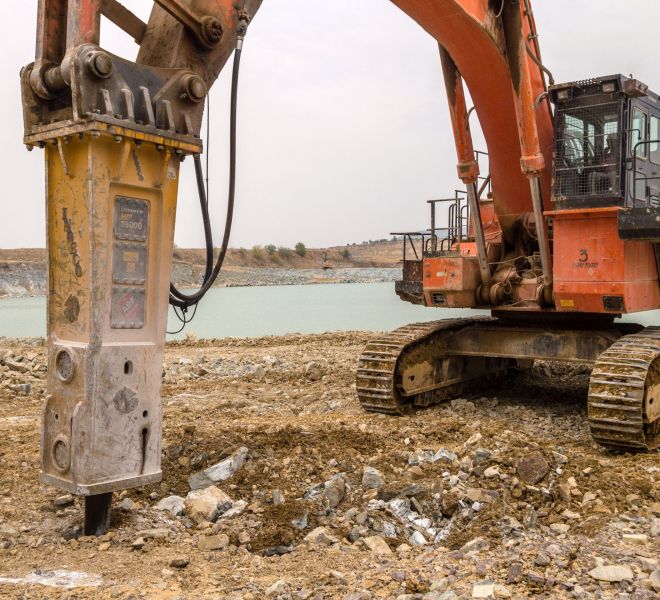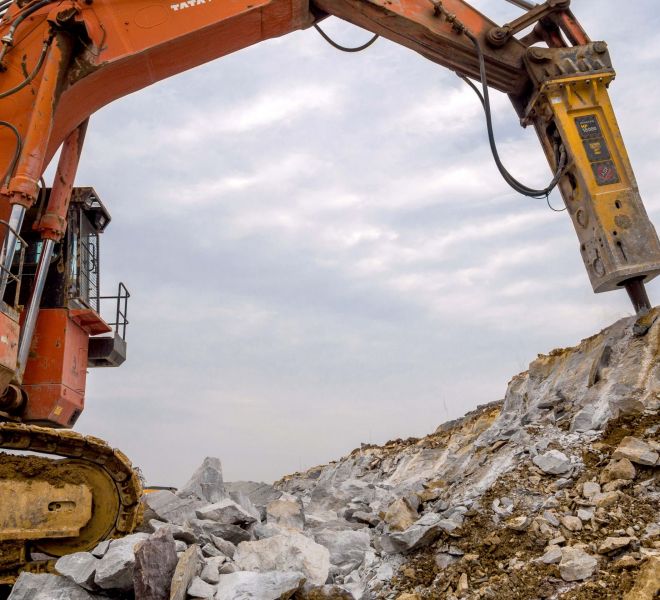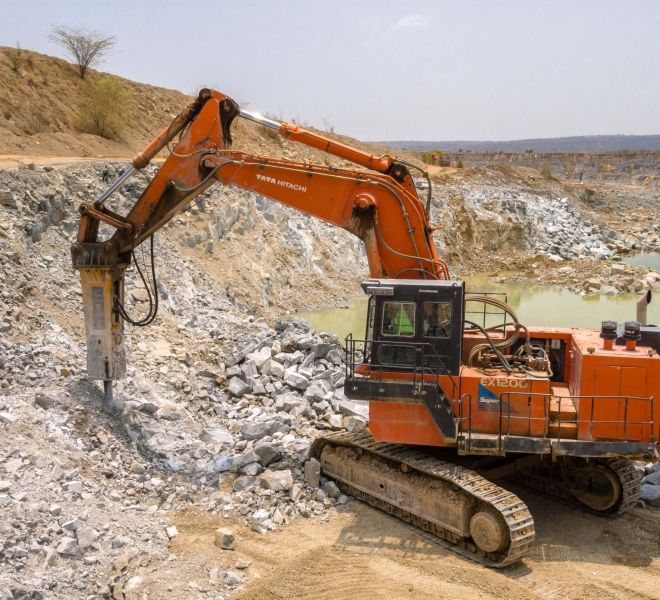The HP 18000 rises to the challenge of an indian quarry
Four HP 18000 breakers are giving their all in a limestone quarry in India. The hardness of the material and the high production output required once again spotlight the advantages of the world’s largest breaker currently in production.
The Chittorgarh quarry in the Indian state of Rajasthan is managed by the cement production division of Birla Corporation, and its limestone supplies the cement factory of Chanderiya owned by the same company and located seven km from the quarry. Birla Corporation is part of MP Birla Group, a multinational conglomerate with over 120,000 employees that does business in 40 countries across a broad spectrum of industries, including mechanics, textiles, chemical energy and cement production. With its seven plants, of which Chanderiya is one of the most important, Birla Corporation has a production potential of over 6.5 million tons of cement per year.
Until 2011 the quarry, with reserves lasting over 20 years, was mined by drilling and blasting. In that year, however, the Rajasthan High Court ruled that the technique could no longer be employed as it risked damage to the nearby Chittorgarh Fort, a national monument dating to the 14th century. The Court’s decision had a consequent impact on the way the quarry organized production, requiring it to reconvert to a method using mechanical systems, and prompting the company to invest in a fleet of machines and hydraulic breakers that would ensure the required production levels.
The hardness challenge
The Chittorgarh quarry contains enormous quantities of Nimbahera limestone, part of the Vindhyan Supergroup, one of the thickest sedimentary marine deposits of the Precambrian era to be found in India. The formation stretches from west to east in the northern part of the country with several outcrops present in areas of Rajasthan. The part of the quarry currently being mined is characterized by a small plateau and the sedimentary formation has a form of a basin and dome with synclines and anticlines. The limestone has variable compressive strength according to its color (Pink = 130 -150 MPa, Light Grey 110-130 MPa, Dark Grey 120-150 MPa, Green 100-120 MPa), and according to type, a percentage of calcium carbonate that ranges from 72% to 88%. Fragmentation also varies, and this together with the compressive strength, makes the production output strictly depend on the type of material being quarried.
The mandatory switch from explosives to mechanical systems posed a challenge from many perspectives, as explained the president of the cement factory, VK Hamirwasia. “The decision of the Rajasthan High Court created the conditions for a change in the way we mine the quarry, as well as production methods and logistics to a certain extent. Our investments have enabled us to guarantee the maximum output achievable using mechanical systems, but because we’ve had to increase the quantity of material, soon we’ll also have to increase the number of machines and equipment in our fleet too.”
Right now, 16 excavators (Hitachi 1200, Komatsu 1250, Liebherr 984) attached with seven breakers (four of which Indeco HP 18000) are operating on a rotating basis over three shifts. This does not count other excavation equipment, such as hydraulic rippers and impact hammers.
Quarry manager MK Ahmed gave us a description of the production cycle. “The quarry has to supply the cement factory 15,000 tons a day, but with the mechanical systems we’re using now, we can only manage to produce 7,500 tons, so we’re forced to integrate the production with material from another quarry. This is in part dictated by a problem in the quality of the Chittorgarh material, which does not fully meet the required standards. We should point out that quarrying using mechanical systems yields variable results according to the type of material being broken up. This ranges from approximately 170 tons per hour of fractured material to about 110 tons of compact material. We’ve had good results with the hydraulic breakers, whereas the impact hammers have given serious problems when it comes to reliability, also because they are used in areas where the limestone reaches, and sometime exceeds, 140 MPa, a challenge for any mechanical system. Indeco breakers, conversely, have proved very productive and reliable, especially when we consider that they’re used on a rotation basis over three shifts in a very heavy application. By now they have racked up a high number of hours in weather conditions that sometimes see temperatures of over 45 degrees. The HP 18000, with its 25,000 joules, is undeniably the most powerful breaker on the market today. What’s more, it offers the additional advantage of being coupled with 90-ton excavators, and this is a very positive aspect for us. Besides the clear and immediate savings on the purchase price, there are other longer-term savings on fuel consumption, which may even lead to much lower operating costs over time.”
A test of long-term reliability
Designed as a breaker for special quarrying operations, the HP 18000 is seeing a success that while not up to the levels of the HP 12000, is clearly showing the extent to which this model has hit the mark from a technical and commercial standpoint. The growing obstacles in using explosives due to environmental or safety concerns best explains the interest by many quarry operators for this model of the Indeco range. That said, other reasons have become apparent during the experience in the Chittorgarh quarry, thanks to this model’s top-notch reliability even when used in an especially tough application such as the Rajasthan quarry. The four HP 18000 operated by Birla Corporation (their number will soon rise to six ) are utilized for the layers of light grey and green limestone, materials with a hardness ranging from 100 to 120 MPa. The use of Cobra chisels together with the high power available has proven effective, but the breakers are working on a continuous, not sporadic, basis in a demanding application that tests the “physiological” limit of the breaker. As a result, service plays a basic role in guaranteeing efficiency in a situation where the breaker is constantly forced to give the maximum. This important function is performed by Indian dealer DCS Technoservice, who has a trained technician assigned to the quarry to deal with all maintenance aspects and to coordinate the dealer’s workshop mechanics present on-site. This creates the conditions for ensuring the optimum performance of the breakers, as pointed out by Abhay Kaskebar, general manager and partner of the dealership. “The supply of breakers to Birla Corporation has been extremely important to us, not only in economic terms, considering that other orders will soon be following, but also because the prestige of the Birla name is a very important reference for us on a national scale. We also have to consider that the very heavy work of these breakers is a point in favor of their reliability and hence an additional marketing tool. This is also the reason why we’ve placed ourselves at the total disposal of Birla Corporation, who has perfectly grasped how much they can count on our service beyond the quality of the product itself. From this viewpoint, our thanks go to Indeco, who has consistently provided the technical and sales support to meet the demands of our customers.”










